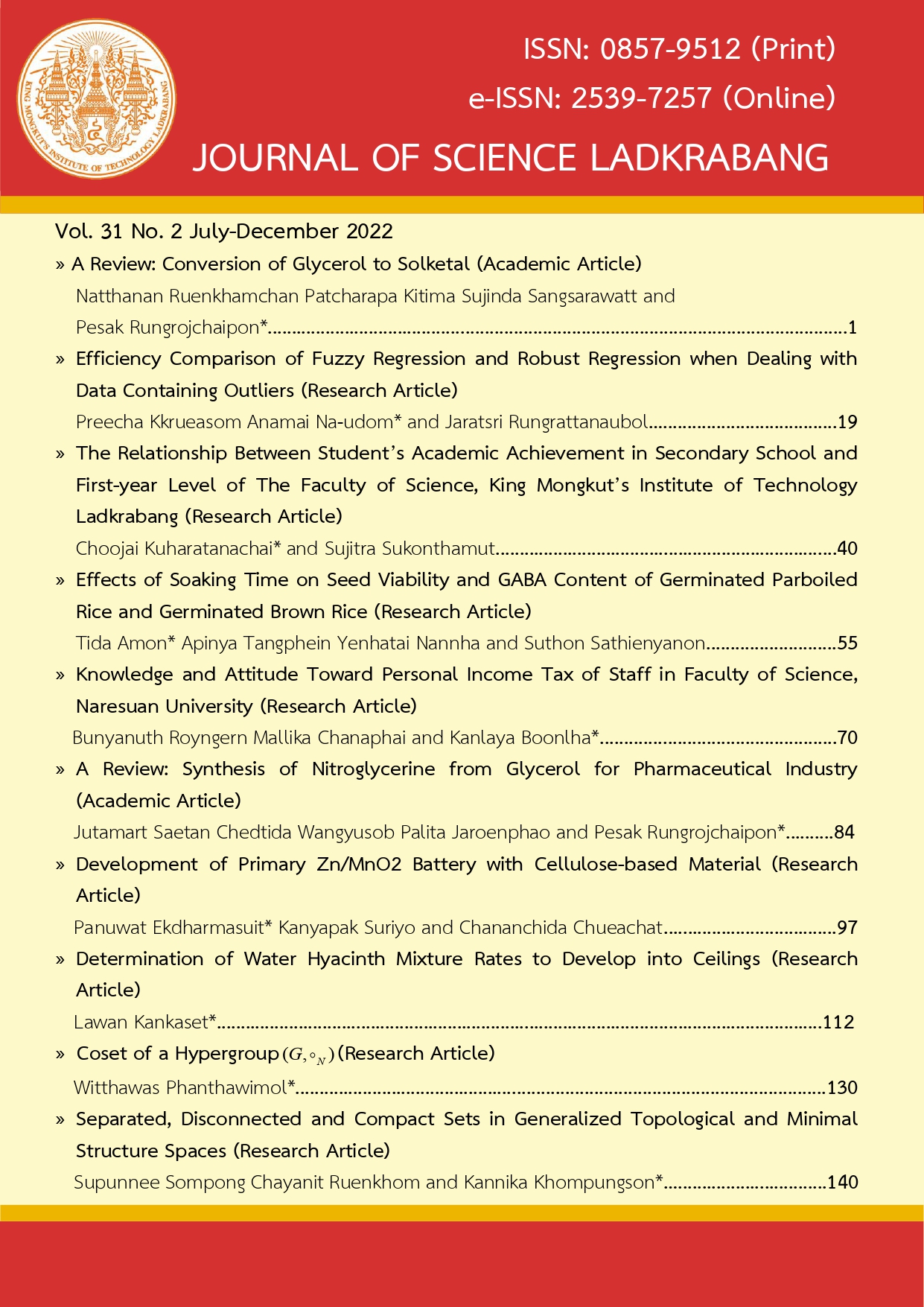Determination of Water Hyacinth Mixture Rates to Develop into Ceilings
Main Article Content
Abstract
The research aims to study water hyacinth ingredient rates in ceiling development, with water hyacinth being added as an added ingredient. As a consideration for the development of ceiling panels and reducing the current large amount of hyacinths, the researchers took a ceiling panel with a ratio between gypsum: water: sodium silicate and hyacinth by weight. Tested for breaking strength and transverse crack pressure. Swamping, water absorption, density The coefficient of thermal conductivity and nail pull resistance according to the TISI 219-2009 industrial product standard of 5 ratios is 1:1:0.03:0, 1:1:0.03:0.60, 1:1:0.03:0.65, 1:1:0.03:0.70 and 1:1:0.03:0.75 Test showed that ceiling panels containing hyacinth mixtures added to the ratio of 1:1:0.03:0.60 were the most valuable in terms of testing due to longitudinal and transverse pressure. Maximum nail pull resistance labor The benchmark value is in the benchmark. Compared to other ingredient rates, this developed ceiling sheet can reduce the amount of water hyacinth that are currently available and help with the environment.
Article Details

This work is licensed under a Creative Commons Attribution-NonCommercial-NoDerivatives 4.0 International License.
References
ดวงจันทร์ เกรียงสุวรรณ. 2555. บทความวิทยุ รายการสาระความรู้ทางการเกษตร คณะทรัยากรธรรมชาติมหาวิทยาลัยสงขลานครินทร์ วิทยาเขตหาดใหญ่. [Daungjan KriengSuwan.2012 Agricultural Knowledge Program, Faculty of Natural Truyakorn, Prince of Songkla University Hat Yai Campus (In Thai)]
ฉัตรวีระ นิมิตยงค์สกุล. 2537. การใช้เส้นใยผักตบชวาเป็นสารเสริมแรงแบบสุ่มในแผ่นหลังคา. วารสารวิศวกรรมศาสตร์, 21(ฉบับพิเศษ 1),77-92. [Chatveera Nimityongskul. 1994. Use of Water Hyacinth Fiber as Randomly-Oriented Reinforcement in Roofing Sheets, KKU. Journal of Engineering, 21(1), 77-92. (In Thai)]
ชนาทิพย์ จักรกร และสมชาย เจียจิทสวัสดิ์. 2558. ผลิตฉนวนกันความร้อนจากเส้นใยผักตบชวาและน้ำยางธรรมชาติ. NU วารสารวิทยาศาสตร์นานาชาติ,19(2), 59-68. [Chanatip Jaktorn and Somchai Jiajitsawat. 2014.Production of thermal insulator from water hyacinth fiber and natural rubbe latex. NU. International Journal of Science, 11, 31- 41. (In Thai)]
อิศรางกูร จันทวงศ์. 2553. การศึกษาสมบัติเชิงกลขององค์ประกอบคอนกรีตมวลเบาที่มีไมโครไฟเบอร์. วารสารวิทยาศาสตร์ลาดกระบัง. 19(2), 59-68. [Israngkoon Chantawong. 2010. Study of Mechanical Properties of Autoclaved Aerated Lightweight Concrete Element Containing Microfiber. Journal of Science Ladkrabang. 19(2), 59-68. (In Thai)]
ประโยชน์ผักตบชวา. แหล่งข้อมูล: http:/www.tanud.go.th. ค้นเมื่อวันที่ 14 กันยายน 2562.
ฉนวนกันความร้อน. แหล่งข้อมูล: http://www.rf-m.com/index.php?Lay= show&ac=arti-cle&ld=538770015. ค้นเมื่อวันที่10 ธันวาคม 2557.
สุวัฒชัย ปลื้มฤดี . 2551. การพัฒนาคอนกรีตบล็อกจากผักตบชวา. วิทยานิพนธ์ปริญญาสถาปัตยกรรมศาสตร มหาบัณฑิต ภาควิชาสถาปัตยกรรม มหาวิทยาลัยศิลปากร. [Suwatchai Pleumruedee. 2008. Concrete Block Development from Hyacinth.Master of Architecture Thesis, Department of Architecture, Silpakorn University. (In Thai)]
พยุงศักดิ์ ศรีอำไพ. 2562. ศึกษาคุณบัติเชิงกล และคุณสมบัติทางกายภาพของผลิตภัณต์มอร์ต้าเส้นใยผักตบชวา. แหล่งข้อมูล: http//ti-nyurl.com/311-0024Abstract-doc. ค้นเมื่อวันที่10 ธันวาคม 2562.
กิตติ เติมมธุรพจน์, โสภา วิศิษฏ์ศักดิ์ และโจเซฟ เคดารี. 2554. การพัฒนากะลาปาล์มบล็อกน้ำหนักเบาที่มีประสิทธิภาพในการลดความร้อนเข้าสู่อาคาร. วิทยานิพนธ์ปริญญามหาบัณฑิต สาขาวิชานวัตกรรมอาคาร คณะสถาปัตยกรรมศาสตร์. มหาวิทยาลัยเกษตรศาสตร์. [ Kitti Tommuth, Sopa Wisitsak and Joseph Kedari, 2011. Developed a lightweight palm block shell that is effective in reducing heat entering buildings. Master of Science Thesis in Building Innovation, Faculty of Architecture. Kasetsart University. (In Thai)]
วรรณี เอกศิลป์ และ ชัยรัตน์ บุญถนอมวงศ์. 2557. ประสิทธิภาพฉนวนกันความร้อนของบล็อกคอนกรีตผักตบชวาผสมขี้เลื่อย, การประชุมวิชาการวิจัยแห่งชาติ ครั้งที่ 1 มหาวิทยาลัยรังสิต, ปทุมธานี [Wannee Eksart and Chairat Boonthanomwong. 2014. Thermal Insulator Performance of Water Hyacinth and Sawdust Hollow Concerte Block. Proceedngs 1th National Research Conference Rangsit University, Pathumthani. 179-186. (In Thai)]
ปราโมทย์ วีรานุกูล, กิตติพงษ์ สุวีโร และอิทธิ วีรานุกูล. 2561.ผลิตภัณฑ์แผ่นฝ้าเพดานผสมขุยมะพร้าวที่มีสมบัติความเป็นฉนวนป้องกันความร้อน.วารสารวิศวกรรมศาสตร์ ราชมงคลธัญบุรี, 16(2), 129-38. [Pramod Veeranukul, Kittipong Suweero, Itthi Veeranukul. 2018. Coconut coir ceiling board product with thermal insulation property.Journal of Engineering, RMUTT. 16(2),129-38. (In Thai)]
Ohama Y. 1987. Principle of Latex modification and some typical properties of Latex-modified mortars and concretes. ACI Materials Journal. 84(45),511-8.
ปราโมทย์ วีรานุกูล. 2562. ผลิตภัณฑ์แผ่นฝ้าเพดานผสมขุยมะพร้าวที่มีสมบัติความเป็นฉนวนป้องกันความร้อน สําหรับชุมชนท้องถิ่น. การประชุมวิชาการมหาวิทยาลัยเทคโนโลยีราชมงคลแห่งชาติ, ครั้งที่ 11,เชียงใหม่, ศูนย์ประชุมและแสดงสินค้านานาชาติแห่งประเทศไทย. มหาวิทยาลัยเทคโนโลยีราชมงคลล้านนา, 244-259 [Pramod Veeranukul . 2019. Coconut coir ceiling board product with weter resistence and thermal insulation property for local communities. Proceedings of the 11th National Conferrence of Rajamangala University of Technology. Chiang Mai, Thailand International Convention and Exhibition Centre. Chiang Mai Rajamangala University of Technology Lanna. 244-259.(In Thai)]
กิตติพันธ์ บุญโตสิตระกูล 2550. การศึกษาทางกายภาพและทางกลของบล็อกคอนกรีตผสมกับน้ำยางพารา รายงานฉบับเต็ม กรุงเทพฯ: สํานักงานกองทุนสนับสนุนการวิจัย. [Kittiphan Boontosi takun. 2007. Study of physical and mechanical of concrete block mixed with Para latex. Full Report. Bangkok: Thailand Research Fund. (In Thai)]
Ghosh SR, Saikai DC, Goswami T, Chaliha BP and Baruah JN. 1984. Utilization of water hyacinth (Eichhornia crassipers) of paper and bord making. Proceedings of the International Conference Water Hyadinth. Feb. 7-11; Nairobi:UNEP. 436-460.
สํานักงานมาตรฐานผลิตภัณฑ์อุตสาหกรรม (สมอ.) 2552.มาตรฐานผลิตภัณฑ์อุตสาหกรรม ฉบับที่ 219- 2552. ยิปซั่มบอร์ด. กรุงเทพฯ: สํานักงานมาตรฐานผลิตภัณฑ์อุตสาหกรรม (สมอ.) [Thai Industrial Standards Institute (TISI). 2009.Thai Industrial Standard No.219-2009. Gypsum Board. Bangkok: Thai Industrial Standards Institute. (In Thai)]
American Society for Testing and Materails (ASTM). 2012. Annual Book of ASTM Standards.Philadelphia; American Society for Teating and Materials.
ปริญญา จินดาประเสริฐ และ ชัย จาตุรพิทักษ์กุล ซีปูนซีเมนต์ปอซโซลาน และคอนกรีต ครั้งที่ 7. กรุงเทพฯ : สมาคมคอนกรีตไทย ACI ร่วมกับ สมาคมคอนกรีตแห่งประเทศไทย 2555. [Parinya Jindaprasert and Chai Chaturpakkul. cement, Pozzolan, and Concrete. 7 th ed. Bangkok : ACI Partners with Thailand Concrete Association; 2012. (In Thai)]
Fherty, Keith F. and Williamson, Thomas G.1995. Wood Engineering and Construction Handbook. 2 nd ed, New York. Mc Graw - Hill.
อนุภา สกุลพาณิชย์ พ.ศ. 2559. การพัฒนาฉนวนกันความร้อนสู่อาคารจากซังข้าวโพดและน้ำยางธรรมชาติ. วารสาร E-Journal มหาวิทยาลัยศิลปากร 1(9), 1688-1702. [Anupa Sakulpanich.2016. The Development of Building Thermal Insulation from Corncob and Natural Rubber Latex. Veridian E-Journal, Silpakorn University, 1(9), 1688-1702. (In Thai)]

